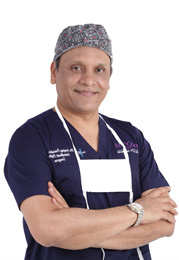Varicose Veins
Varicose veins, also known as varicose or varicosities develop when the veins become abnormally enlarged, shrunk or overflows with blood. Varicose veins are mostly painful and are identified by their red or bluish-purple color. Varicose veins can be seen swollen or raised. Varicose veins are a common medical condition seen in women over the age of 50 years and develop mostly in the veins of the lower legs.
What are the causes of Varicose Veins?
Varicose veins develop due to abnormality in the veins. Veins are fitted intermittently with one-way valves that prevent blood from flowing backwards. At times, these valves may malfunction and blood begins to accumulate behind the damaged valve. As the legs are farthest from the heart, gravity has more effect on the veins in the legs and are commonly found in the lower extremities.
These are some of the causes which result in the valves of the veins to malfunction and develop varicose veins:
- Chronic heart valve disorders
- Menopause
- Pregnancy
- Standing for longer periods of time frequently
- Abdominal pressure
- Obesity
What are the signs and symptoms of Varicose Veins?
Initially, varicose veins can be identified due to its abnormal shape and mostly are found in the legs. Pain or ache along with swelling and heaviness in the leg is also experienced in the legs. In certain cases, discoloration, ulcers and swelling can also be seen around the ankles.
How are Varicose Veins diagnosed?
The doctor will initially perform a physical examination. This will likely include visual examination of the suspected veins in the legs when the patient is in the standing or sitting position. The doctor will also ask about pain or any other symptom being experienced. The doctor may also perform an ultrasound test for blood flow. This non-invasive diagnostic technique uses high frequency sound waves to visualize the blood flowing in the vein.
An angiogram is advised in some cases, to perform a detailed diagnosis. A special dye will be injected into the legs and high powered x-ray imaging allows the doctor to see the veins better with the contrasting dye highlighting the flow of blood better. These imaging diagnostic tests are performed to check the veins for obstructions or blockages that cause swelling and pain in the legs.
How are Varicose Veins treated?
Initially, the doctor is likely to advise making certain lifestyle changes, such as:
- Avoiding continuous standing for long time at a stretch
- Avoiding overexposure to the sun
- Maintain healthy weight range
- Exercise to improve strength in legs
- Avoid keeping your legs crossed for long periods of time
The other forms of treatment of varicose veins include:
- Compression : The doctor advises wearing specially designed stockings/pantyhose that are built for constant compression. This constant pressure on the legs allows blood to flow back efficiently to the heart.
- Surgery : If lifestyle changes and compression stockings are not successful in treating varicose veins, then the doctor will advise surgical treatment. Surgical treatment of varicose veins mainly involves ‘vein stripping’. This surgical is performed under general anesthesia to avoid pain or discomfort to the patient. The surgeon will make an incision along the damaged (varicose) veins to remove them. This is an effective treatment to provide relief from intense pain and avoiding risk of other health complications due to severe varicose veins. The current method of performing vein stripping is a minimally invasive surgical procedure which offers less recovery time.
- Alternate treatments: Radiofrequency or lasers might also be used to target the blockage in the veins or to seal blood flow to a particular vein.




